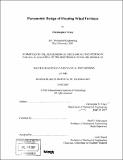Parametric design of floating wind turbines
Author(s)
Tracy, Christopher (Christopher Henry)
DownloadFull printable version (10.17Mb)
Other Contributors
Massachusetts Institute of Technology. Dept. of Mechanical Engineering.
Advisor
Paul D. Sclavounos.
Terms of use
Metadata
Show full item recordAbstract
As the price of energy increases and wind turbine technology matures, it is evident that cost effective designs for floating wind turbines are needed. The next frontier for wind power is the ocean, yet development in near shore waters has been slowed by aesthetic concerns of coastal residents. Going further offshore eliminates these aesthetic concerns and has the additional advantage of stronger and more consistent winds. However, the vast majority of promising locations beyond the view of land are in sufficiently deep water to make building a rigid structure to the ocean floor economically infeasible. Cost effective floating structures are needed to enable wind farm installation in deep water and increase the world's installed base of renewable energy. This thesis presents a parametric approach to the design of these floating structures for offshore wind turbines. It starts with the relevant design concepts from the offshore oil gas industry and presents appropriate combinations of structures and mooring systems that meet the requirements for a generic five mega watt wind turbine. The results of the parametric study are a number of designs that show Pareto fronts for mean square acceleration of the turbine versus multiple cost drivers for the offshore structure. These cost drivers include displacement of the floating structure and total mooring line tension.
Description
Thesis (S.M.)--Massachusetts Institute of Technology, Dept. of Mechanical Engineering, 2007. Includes bibliographical references.
Date issued
2007Department
Massachusetts Institute of Technology. Department of Mechanical EngineeringPublisher
Massachusetts Institute of Technology
Keywords
Mechanical Engineering.